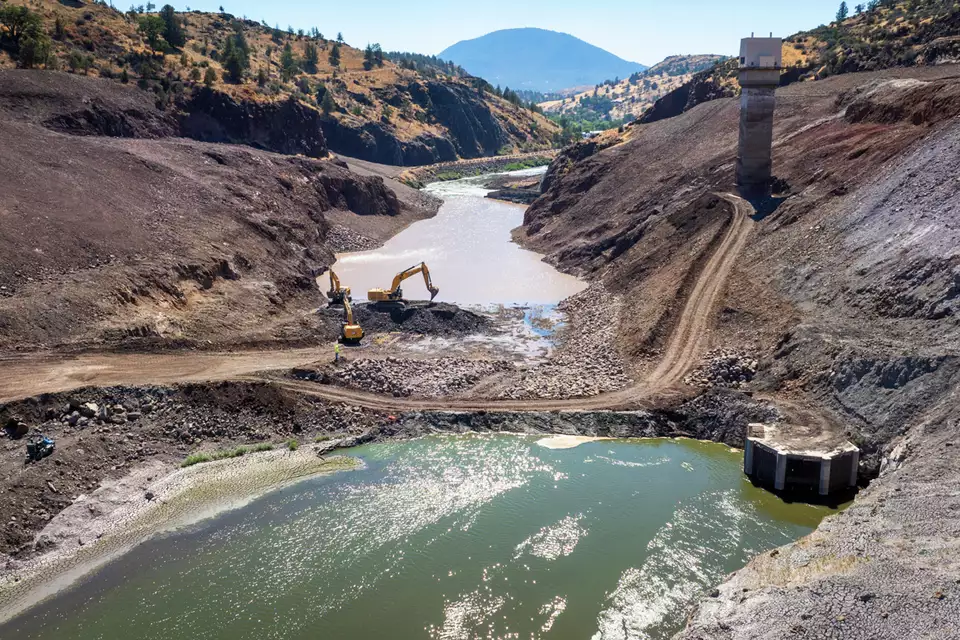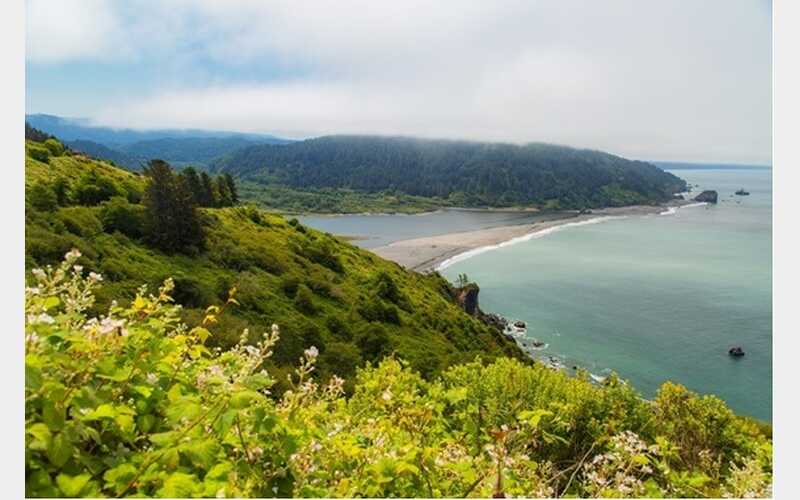[ Envirowatchers ] [ Main Menu ]
19247

From: ryan, [DNS_Address]
Subject: the Klamath runs free again...
URL: https://www.sfgate.com/bayarea/article/california-dam-removal-final-stage-river-flows-19734249.php
|
this should help the salmon recover... As California dam removal hits final stage, river flows freely for first time in a century By Sam Mauhay-Moore, Trending News Reporter Aug 31, 2024 Crews work at the Iron Gate cofferdam site along the Klamath River on Tuesday, Aug. 27, 2024, in Siskiyou County, Calif. Shane Anderson/AP The decades-long push led by tribal communities to remove four dams along the Klamath River reached another victory this week as crews began the project’s final stages, restoring historic water flows to the river for the first time in over a century. Crews planned to break down the last remaining cofferdams — infrastructure built to divert water around the larger dams’ original construction sites — at the Iron Gate and Copco No. 1 dam sites in Siskiyou County this week, the Klamath River Renewal Corp. announced on Tuesday, and did so. Now, the river can flow freely between Lake Ewauna in Klamath Falls, Oregon, to the Pacific Ocean for the first time since the dams were constructed between 1903 and 1962. “We had a really incredible moment to share with tribes as we watched the final cofferdams be broken,” Ren Brownell, KRRC’s public information officer, told SFGATE. “So we've officially returned the river to its historic channel at all the dam sites. But the work continues.” Some pieces of remaining dam infrastructure, like diversion tunnels and remnants of the cofferdams, still need to be removed before the project is completed, Brownell said. Barring adverse weather conditions or wildfires, KRRC expects that process to finish up by the end of September. The fight to remove dams along the Klamath began over two decades ago, when poor water quality and river flows caused tens of thousands of the river’s fish, mostly Chinook salmon, to die in a massive fish kill in 2002. For thousands of years, Chinook salmon have been a fundamental source of physical, spiritual and economic sustenance to tribal communities throughout the Klamath Basin. After the fish kill, tribes like the Yurok and Karuk began a fierce advocacy campaign that insisted that removing the dams is a necessary step toward reviving the original ecosystems, migratory routes and spawning grounds of the salmon. A plan to begin the dam removal process was approved by federal regulators in 2022. “Restoring hundreds of miles of spawning grounds and improving water quality will help support the return of our salmon, a healthy, sustainable food source for several Tribal Nations,” Russell “Buster” Attebery, chairman of the Karuk Tribe, said in a Wednesday news release. “This is truly a great day for the Karuk and all the Native People of the Klamath Basin.” The first noticeable impacts of the project aren’t necessarily going to be positive ones, Brownell said. As water flows are restored to the river, sediment made of mostly dead algae will be released downstream, turning the waters of the Klamath temporarily murky and turbid. “When we slowly drained the reservoirs before we could remove three of the dams, we sent the majority of those sediments downstream,” Brownell said. “But with the final cofferdam breach this week, we're sending another little pulse of sediment down downstream right now. So it does have short-term water quality impacts.” The good news? The sediment might be aiding the restoration of plant life in the basin. “The majority of these sediments are dead algae, and we actually found that plants grew really well in it,” Brownell said. Local tribes aren’t the only communities impacted by the dams — commercial fishers who live and work along the coasts of Northern California and Southern Oregon have also been hit hard by salmon declines over the past several decades. Then there are the farmers and ranchers who have relied for years on the irrigation provided by the dams, mainly in the Upper Klamath Basin, north of where the removal process is taking place. “There's a forward-looking component to the project: We've got all these different groups in the river basin who rely on water for very different purposes,” Bryan Tilt, professor of anthropology at Oregon State University, told SFGATE. “And to what extent do their interests and their priorities about management overlap? And can we think about ways going forward to find management alternatives that are broadly beneficial, and what are those alternatives?” Locals and experts are still searching for those answers, Tilt said. But one thing is certain: Changes brought on by the dam removals have been, to many, a long time coming. “The dams that have divided the basin are now gone and the river is free,” Frankie Myers, vice chairman of the Yurok Tribe, said in Wednesday’s news release. “Our sacred duty to our children, our ancestors, and for ourselves, is to take care of the river, and today’s events represent a fulfillment of that obligation.” |
19257

From: Jeff/Lake Almanor,CA, [DNS_Address]
Subject: Re: the Klamath runs free again...
|
Klamath River Fishery Plan Calls for Wild, Self-Sustaining Salmon, Steelhead Populations in Newly Undammed River. The California Department of Fish and Wildlife (CDFW) has released the “Klamath River Anadromous Fishery Reintroduction and Restoration Monitoring Plan,” a 60-page blueprint to guide the reintroduction and monitoring of Chinook salmon, coho salmon, steelhead and Pacific lamprey in a newly undammed Klamath River. The plan’s principal goal is to reestablish viable, wild, self-sustaining populations for species conservation, ecological benefits and to enhance Tribal, commercial and recreational fisheries. The primary strategy is to allow these ocean-going fish species to naturally recolonize some 420 miles of newly accessible spawning and rearing habitat. The last two remaining barriers – cofferdams at the former Iron Gate and Copco No. 1 dam footprints – were breached this week, returning the Klamath River to a free-flowing state in California for the first time in a century. “The largest dam removal project in American history is part of something even bigger as we work with countless partners to achieve the largest river restoration project in American history, which is a super exciting space to be in,” said CDFW Director Charlton H. Bonham. “Nature teaches us time and time again just how resilient she is. If we can mostly stay out of the way, these fish populations will heal themselves, sustain themselves and help heal and sustain the communities that cherish them. There is no bigger game-changer underway for Pacific salmon in the West than this effort.” The Klamath River anadromous fishery plan was prepared in collaboration with Native American Tribes, the State of Oregon and federal partners, including NOAA Fisheries and the U.S. Fish and Wildlife Service. Beyond the newly available habitat within the main stem of the Klamath River, anadromous fish species also have access to several important tributaries upstream of the Iron Gate Dam footprint that historically supported these fish through several critical life stages and will provide reliable sources of cool water in warmer months and in warming climate conditions. These tributaries include Scotch, Camp, Jenny, Shovel and Fall creeks. Fall Creek will play a significant role in the restoration of the Klamath River. The creek is home to the newly constructed, $35 million Fall Creek Fish Hatchery intended to jump-start salmon populations in the upper basin. The Fall Creek Fish Hatchery replaces CDFW’s Iron Gate Fish Hatchery. It was built by PacifiCorp, the former owner and operator of the hydroelectric facilities on the Klamath River. PacifiCorp is slated to fund hatchery operations for the next eight years. Annual production goals consist of 3.25 million fall-run Chinook salmon and 75,000 coho salmon. The Klamath River Anadromous Fishery Reintroduction and Restoration Monitoring Plan calls for an “adaptive management approach,” which means future management decisions and strategies can change based on extensive monitoring detailed in the plan and coordination with Klamath Basin fisheries partners. ### |
Responses:
None
19248
From: Redhart, [DNS_Address]
Subject: Re: the Klamath runs free again...
|
woohoo! Run river, run! spawn salmon, spawn! |
19249
From: ryan, [DNS_Address]
Subject: Re: the Klamath runs free again...
| c'mon, they're just fucking fish...lol... |
Responses:
[19250]
19250

From: Redhart, [DNS_Address]
Subject: Re: the Klamath runs free again...(NT)
| (NT) |
Responses:
None
[ Envirowatchers ] [ Main Menu ]